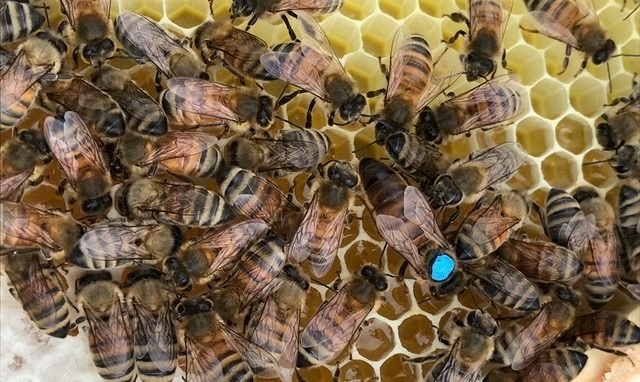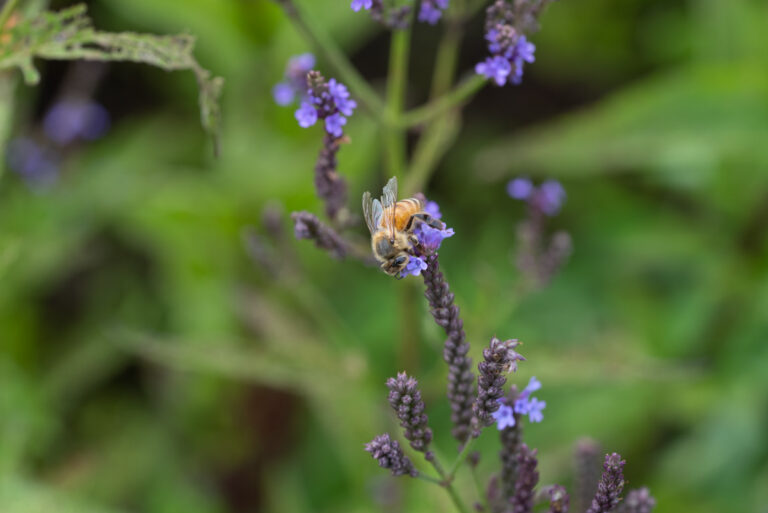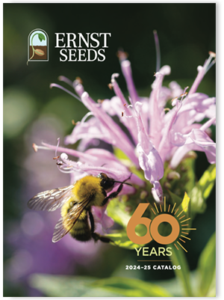The PA Queen Project and the HHBBC, with support from Penn State University and Purdue University, collaborated on a study comparing colonies with varroa mite-resistant queens versus non-varroa mite-resistant queens from 2018 to 2019.
The study enlisted 100 hobbyist beekeepers in the comparison study with the objective of helping change their behavior to promote varroa mite management through best practices. Many consider the varroa mite to be the single greatest threat against sustainable beekeeping across the world, meaning management of the mite is imperative in supporting healthy colonies. The full final report can be viewed here.
Charlie Vorisek is the owner of Vorisek’s Backyard Bee Farm in Linesville, PA and was one of the beekeepers involved in the ‘blind queen’ study.
The varroa mite has had a deadly impact on honeybee colony health with studies showing it leads to Colony Collapse Disorder. What can you tell us about the varroa mite and efforts to prevent it?
Charlie Vorisek: Since the early 1990s the varroa mite has been the leading plague of honeybees. In the ’90s some synthetic miticides were developed that were about 98% effective. Because mites reproduce so fast and interbreed, the surviving mites developed resistance to the only two synthetic products. By the early 2000s, those products were no longer effective. Colony Collapse Disorder (CCD) got its official recognition in 2006, although many would say it began years before. Much chemical study has been done since 2006. Since that time, many products have been used for varroa mite control.
Today we have three to four organic treatments and one somewhat reliable synthetic. Organics are the tool of choice, since they do not leave any residual product in the honey and can be used while bees are making surplus honey. The downside of organic treatments are they can be equally harmful or ineffective and require more frequent monitoring and application.

What is the best solution for eliminating the varroa mite?
Charlie Vorisekr: This is a very tough question. We are challenged with killing a bug on a bug that reproduces within the cell of the host larvae. Scientists have been working on this for a long time. Novel new ideas appear on the market every year. It seems clear to me that human intervention is not a sustainable solution. We clearly don’t have a ’silver-bullet’ solution. Every intervention seems to have limitations and is influenced by variables we don’t fully understand. Additionally, we don’t fully understand the multitude of agriculture chemicals in use from backyards, right of ways and crop production. It’s so complex that I doubt we can ever know what tiny elements favor the bees or mites. My own opinion is we need to continue promoting honey bee genetics that suppress the varroa mite without intervention. We can continue human intervention as a ‘crutch’, so it is still economically feasible to pursue beekeeping. Eventually, we need to wean off human interventions.
The best solution is not something that will happen quickly. The best solution would be if the bees could take care of mites themselves. It is not normal for a parasite to kill its host. (Asian honey bees developed their own resistance. However, the Asian honey bee has other problems and importing is not an option.) Chemical intervention prevents natural selection.
What scientific efforts have been made to increase honeybees’ resistance?
Charlie Vorisek: Since about 2010, the Pennsylvania State Beekeepers Association (PSBA) has been attempting a genetic improvement program, the PA Queen Improvement Project. Recognized through anecdotal evidence, we have bees that seem to have a high survival rate. Bees have been selected for hundreds of years for their behavior, honey production and a host of other characteristics. A nucleus of beekeepers have been trading and selecting bees for disease and mite resistance for many years. A few years ago, Purdue University had access to some un-managed hives that were abandoned. They studied these to understand why they had not succumbed to varroa mites. Under microscope examination, they observed that the dead mites on the hive floor were missing legs and antennae. The bees were grooming the mites off fellow bees and biting the mites’ appendages. These genetic strains have been nicknamed ‘mite-biters’, ‘leg-biters’ and ‘mite-maulers.’

Are there any honey bees that have a good varroa mite resistance?
Charlie Vorisek: Presently, there are several selected genetic strains of honeybees that are claimed to have good mite resistance. Researchers from Purdue University have partnered with Penn State through the PSBA PA Queen Improvement Project and Heartland Honey Bee Breeders Cooperative to study genetic selection of mite resistance.
Funded with a CARE grant, both Pennsylvania and Indiana enlisted citizen scientists to help carry out the study. Geographically, study locations are in nearly every agricultural region of Pennsylvania and several in Indiana. Locally, we started with two sites, but winter mortality reduced it to one site. The Penn State lab of Dr. Margarita Lopez-Uribe with extension specialist Robyn Underwood head up the Pennsylvania locations.
How many genetic strains did the study have?
Charlie Vorisek: The study has five genetic strains. Each location has 20 to 30 colonies, equally divided by genetic strains (colors). To avoid prejudice, the volunteer beekeepers only know the genetic strain by colored queens. We do not know what strains were chosen for the study. The study is referred to as the ‘blind queen’ study.

What more can you tell us about this ‘blind queen’ study?
Charlie Vorisek: The colonies were established in 2020 by introducing each colored queen to an established colony. Monthly inspection verifies the marked queen is present. Each inspection also assesses the brood nest, temperament and monitors mite levels using an alcohol wash method. Colonies with more than a 2% mite level are treated with an organic mite treatment. In spring and fall, university researchers visit each location to inspect and gather samples. The researchers gather samples of bees and mites. Bees are tested for viruses. Mites are examined to determine mite-biting behavior of each colony. Additionally, honey yield will be carefully measured.
What does the study hope to accomplish with this research?
Charlie Vorisek: The research study hopes to identify which genetic strain of honey bee has the highest mite-biting behavior as well as survivability, best temperament and best honey production. To put science based data in place of anecdotal evidence. If successful, the best genetics will be entered in the genetic base for the PA Queen Improvement Project and promoted for beekeepers in Pennsylvania.
How has Ernst Seeds been involved in this research?
Charlie Vorisek: The Ernst directors and staff have long recognized the value of pollinators. Working with them on pollinator services has led to collaborative collaboration with researchers including the Penn State Center for Pollinator Research. As a grower that needs to continuously manage pests, fungus and undesired plants, finding solutions that do not harm pollinators is a priority. Sprayer drivers will stop in the field to tell me what they are applying and the pesticide manager will contact me if a known risk product needs to be applied, so we can coordinate protective measures if needed.
Calvin Ernst allowed the NWPA Beekeepers to set up an apiary in his backyard. This location is used annually for education and is used primarily as a queen mating yard. This yard is ideal as virgin queens fly out to mate with drones from neighborhood colonies. There are roughly 100 survivor and mite resistant colonies within a five mile radius. Flooding the area with desired genetics substantially increases mating success and benefits the quest for mite resistance.
The Ernst field production site was chosen to provide the abundance of foraging opportunity needed for 20 hives in one location. The NWPA Beekeepers Association Field Day at Ernst is an educational event for local beekeepers. It is a live opportunity to do a general hive inspection and answer questions. Another aspect will be handling drones. Drones don’t have stingers and are a perfect candidate for learning to mark queen bees.
Beekeeper members are invited to bring a queenless split or nucleus colony of bees. When the colony raises a new queen, she will be in an area of selected genetics and survivor colonies that will provide the drone mating to pass on the genetics. Another Ernst field production site was chosen for the separate blind genetics study. The location provides an abundance of foraging opportunities needed for 20 hives in one location. This location is a substantial distance from the queen mating yard to minimize influence of unknown/undesired genetic transfer.


